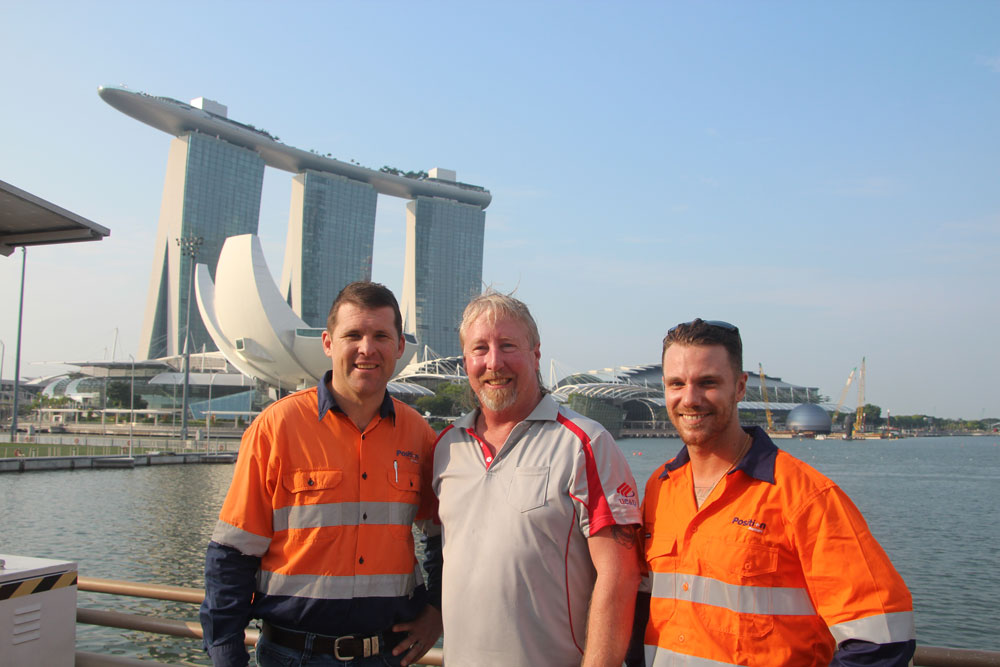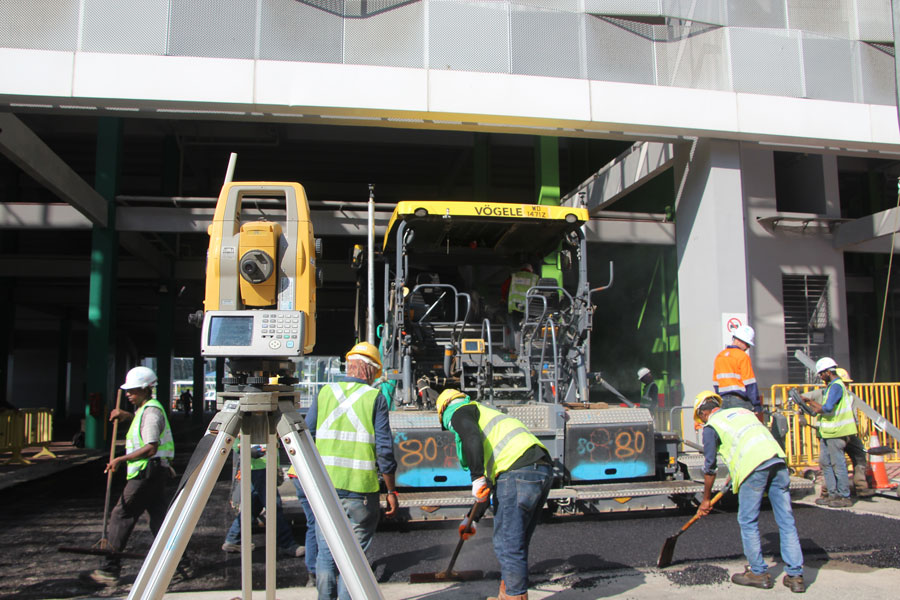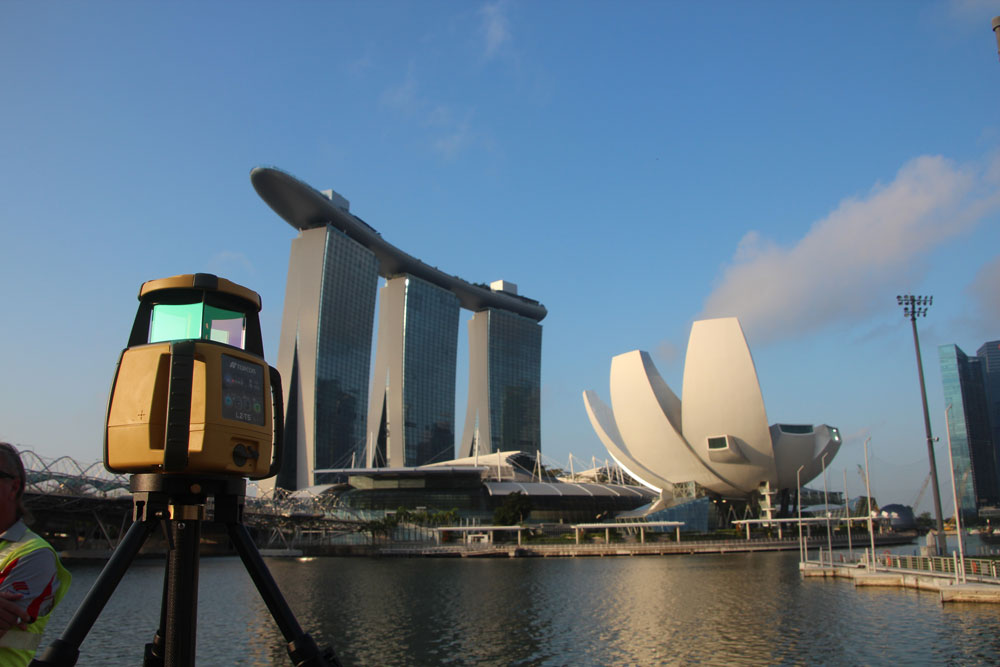Utilising a full range of design, mapping, variable milling, survey and paving machine control technology to transform city streets into a Formula 1 race track.
For the second year running, Singapore contractor United E&P is tasked with preparing the racetrack for the country’s upcoming Formula 1 race in September. Unlike many cities that utilise existing race circuits, Singapore transforms some of the city streets into race car-worthy surfaces in a matter of days, shutting down roads for the shortest periods possible to minimise impact to residents, visitors and traffic.
To meet the tight deadlines and deliver a track that will pass muster with the racing car elite, United E&P has partnered with Topcon Positioning Systems’ largest distributor in the Oceania region, Aptella. Using a full suite of design software, mapping and profiling technology, survey instruments and paving machine control systems, United E&P will begin by scanning and modelling the planned track surfaces before optimising a design and paving the tarmac.

Mathew Connelly and Ricky Hales from Aptella with Graham Castle from United E&P
“Having worked closely with United E&P at Singapore’s Changi airport expansion project in recent years, we have developed a trusted business partnership to utilise technology to its full potential on these cornerstone projects for the country,” said Mathew Connelly, Aptella Manger for South East Asia.
“We assisted United E&P with paving the Formula 1 circuit last year and coming back to complete the track for a second year running demonstrates United’s ability to deliver a high-quality finish on time and within budget,” he added.
The proof is in the drivers’ performance – last year’s track saw Lewis Hamilton complete an All Time Lap Record in a qualifying round, while Kevin Magnussen achieved the Official Lap Record during the race, taking just under eight seconds off the previous record held by Daniel Ricciardo since 2015.

The racetrack has a specification governed by global motor sport safety association FIA (Federation Internationale de l’Automobile). “The tolerances on this job are very tight,” said Graham Castle, Construction Manager at United E&P. “We have a riding index we have to meet, a +/- 3 millimetre tolerance on our levels and also 3 millimetre tolerance under a four metre straight edge for the paved surface.”
The biggest challenge the team faces on site is traffic, Mr Castle explains. “90% of the work needs to be done at night and involves road or lane closures,” he said. “Normally we don’t get road closure until 1am and the road must be open at 5am, so completing the work in four hours is extremely stressful.”
“We want to make road resurfacing and new road construction as efficient as possible,” Mr Connelly continued. “To optimise and enable the best outcome we offer a complete portfolio of hardware, software and services. Our solutions increase productivity and safety, save time and reduce material use. Our scanning solutions collect a constant stream of valuable data. These insights are used to plan and strategize the best possible design.”

United E&P use Topcon’s resurfacing solution to map the existing surface of the circuit. Laser scanning technology is used to model the track, enabling an optimised design to be loaded onto the machines.
MAGNET software is used to create a CAD model for the racetrack, which is then loaded onto paving machines using machine control technology and survey rovers to accurately build to design.
“Using Topcon’s RD-M3 software we can variable depth milling for our machines so we’re milling to the design,” Mr Castle said. “Previously on jobs like these you’d take 50 millimetres out and put 50 millimetres back in, wasting material and not optimising the surface.”
United E&P will utilise a range of Topcon paving machine control solutions – these steer the paver to deliver the smoothest results, automatically correcting the machine for optimal compaction.
Topcon offers a unique machine control system for fine tolerance work including grading and paving applications. Millimetre GPS uses a combination of a high-performance laser transmitter and GNSS positioning technology to create a large working zone that delivers up to 300% greater accuracy than a standard GPS solution alone.
However, in a city with many high-rise buildings, getting a clear view of the sky for GPS technology is not always possible. “Topcon’s Millimetre GPS solution is by far the quickest and most flexible platform when it comes to paving as it can control multiple machines, is fast to setup at the start of a shift and delivers incredible accuracy,” he added.
“But as we can’t get a reliable GPS fix in all areas of the track, we also switch to total station technology to give positioning information to the machines, so we can maintain a consistent level of accuracy across the project. Only Topcon has the ability to utilise GPS, lasers and total stations and switch between them easily, which makes a huge difference when it comes to projects like these that need precision, at speed.”
Survey rovers are used throughout the paving process to check as-built information. “We’re really using every bit of technology we have at our disposal for this job to give a great result in a limited amount of time,” Mr Connelly said.
With the proven results seen from the Changi airport project and last year’s Formula 1 track, Mr Castle is confident of a good result this year. “We’re achieving our tolerances, we’re achieving our ROI the first time,” he said. “Rework doesn’t exist with the workflow we’re using.”

We source, deploy and support intelligent positioning solutions to enhance our customers’ productivity.
Aptella Asia Pte Ltd
UEN 201402777W
Aptella Singapore Pte Ltd
UEN201402784W
2024 Aptella Asia Pte Ltd | UEN 201402777W | Terms and Conditions | Privacy Policy